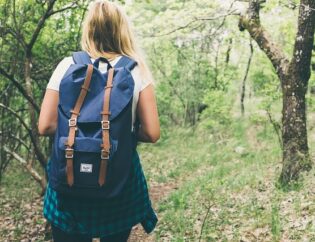
The pandemic has meant that most of us stay local, exploring nearby nature in our neighborhoods with our children. And though such neighborhood walks may seem uneventful, we are actually witnessing one of the biggest problems of our planet each time we admire a neighbor’s landscaping: declining biodiversity.
Biodiversity, or the variety of all living things on our planet, has been declining at an alarming rate in recent years, mainly due to our own activities, such as land-use changes, pollution and climate change.
What do your neighborhood walks with your kids have to do with biodiversity loss? Loss of habitat for one. In the U.S., we have turned 54 percent of the lower 48 states into a suburban/urban matrix. Add up the natural habitat we’ve turned into agricultural land and humans in the U.S. have taken 95 percent of nature and made it unnatural.
So those neat lawns and tidy ornamental plantings we see in our neighborhoods may add curb appeal and show off wealth and social status, but they also reflect a wasteland for biodiversity. In fact, ornamental lawns, neat and tidy plantings are deadly to wildlife.
Why? Because they are largely non-native species. And when we replace native plants with non-native plants, the insects which have evolved so seamlessly to survive with native plants are threatened. Fewer insects are pollinating plants. And fewer insects, in general, means that birds and mammals have less to eat. In essence, we have broken the food web. The new non-native plant cannot pass on the energy it has harnessed from the sun.
In the U.S., we have converted the biodiverse and rich ecosystems of forests and other native habitats with over 40 million acres of lawn and nonnative trees (green grass, perhaps the plant most identified with the American lawn, is not native to many areas in the U.S). As a result, species are disappearing from our neighborhoods, towns, counties, and states.
But here’s the good news. Our actions can bring biodiversity back. Some experts including author and ecologist Douglas Tallamy say our property represents our last chance to sustain plants and animals that were once common throughout the US. If you have a yard and garden, you can help return this habitat to wildlife. And you can involve your kids and teach them why stewardship begins at home.

Here are some ways your family can bring biodiversity to your backyard
Bring back the native plants. Experts say we need to triple the number of native trees in our lawns and underplant them with the understory and shrub layers absent from most managed landscapes. Whether trees, flowers or shrubs, native species are an important element of biodiversity which creates a natural habitat for local wildlife. An added bonus is that native species require less water and maintenance and fewer chemicals than exotic species as they are adapted to the specific conditions of the local environment.
As you do this, you might as well remove exotic plants such as purple loosestrife, which can become invasive and take over your garden and threaten the survival of native species. Kids love to help pull up plants, especially pretty ones! Designate your child the official invasive puller for a specific species of plant. Just make sure they know which ones to pull! Let them know that removing the invasive plants will create space for native plants that are much more appreciated by insects and other critters.
Do nothing. If we stopped cutting our lawns and battling with "weeds," we would create valuable habitat for all sorts of creatures. Yes, the neighbors might not like the look of natural meadow, but use it as an opportunity to educate them about the importance of returning backyard habitats to biodiversity. Have your children make a sign or laminated poster for passers-by.
If that’s too radical, create a wild and free zone. Leave a portion of your yard alone to grow as it wishes, (or go to seed). You’ll cut back on mowing, decrease the amount of watering required and create a safe space for native critters. Let your children adopt this zone as their observation zone. Help them really make it a wildlife-friendly space with water features, birdhouses, bug houses and lots of shelters,

Declare your property a chemical-free zone for wildlife. Chemicals used on our lawns and gardens are harmful to us as well as the environment. Studies have demonstrated that pesticide exposure is particularly harmful to children, and has been linked to various forms of cancer and to the brain and nervous system problems. Use free fertilizer. If you do cut your grass, leave the grass clippings on the lawn so they can fertilize the earth. Also, use compost instead of chemical fertilizers to reduce chemical usage and waste. Composting with your kids is a fantastic and fun activity to help them learn about the brown food chain.
Give away your leaf blower. Leave leaf litter where it is as it provides habitat and food for wildlife and is much needed. Seeds, old berries, and insect pupae and eggs can be important food sources for migrating birds in early spring.

Create a pond for wildlife. Work together with your child to create a small pond in your backyard. Ponds provide habitat for a variety of species ranging from insects to frogs and fish. If space is a limiting factor, a birdbath will attract not only birds but pollinating insects and even chipmunks.
Diversify the habitats. Perennials such as fruit and nut trees, nectar-producing flowers, and berry bushes provide natural shelter as well as food sources for birds, insects, and many mammals. And don't forget to add other features such as rock, log, mulch, and compost piles. Lots of smaller rodents and many insects will make great use of these spaces for shelter and food!











